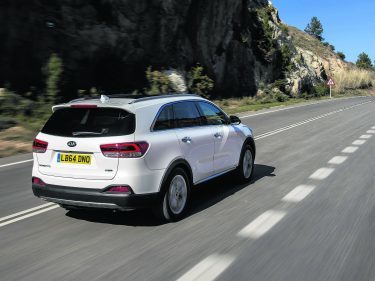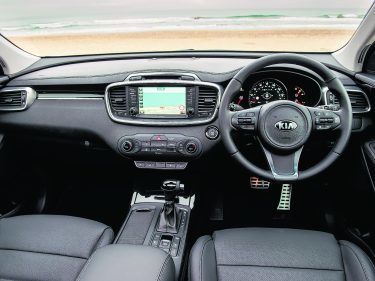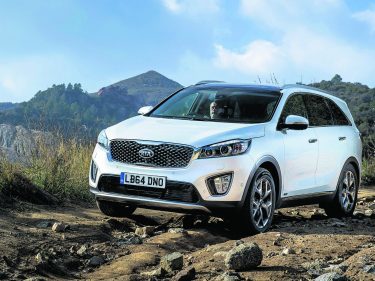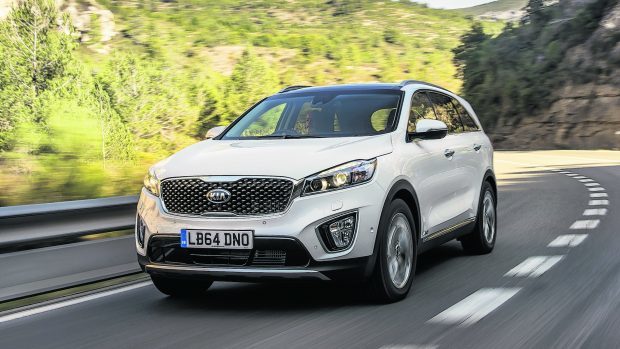Kia’s flagship SUV has a bold new look, but can it compete with its established (and very popular) 4×4 rivals?
The immediately obvious change is that curvy new body, but that isn’t the only change Kia has made to its flagship SUV. Under the skin, there’s an all-new platform with a stronger structure, an upgraded engine range, improved steering and revised suspension.
Inside, the cabin has a more premium feel and there’s some pretty impressive equipment hiding in there too.
The trade-off for all these improvements, though, is a slight price increase – around five per cent, to be exact. So has the Sorento lost its key selling point, or is it merely an even more capable alternative to the seven-seat SUV establishment?
As well as being longer, wider and lower than its predecessor, the new Sorento looks far beefier than the old car, not to mention more curvaceous. The bluff front end is adorned with a rather turgid version of the tiger-nose grille that comes across so aggressively on the Cee’d, and the rounded lights give a distinctly un-Kia-like doe-eyed look.
Nevertheless, it’s actually quite an attractive-looking beast, albeit in a cuddly kind of way. It certainly won’t look out of place in the school car park sitting alongside the XC90s, Outlanders and Q5s of this world.

Because the new Sorento is bigger than its forebear, interior space has greatly improved. In the “standard” five-seat configuration, the 605-litre boot will be more than enough for a family’s holiday luggage or ferrying kids’ sports kit to and from practice sessions.
Pop the two rear seats up to create a seven-seater, though, and that space is compressed to 142 litres, which sounds like more than it is. You’d struggle to fit a small suitcase in there.
The upside of that is that you get seven seats capable of carrying adults, albeit too cramped to be considered comfortable. Kids, however, will likely find they have plenty of room.
Like most SUVs of this size, the Sorento hardly handles like a sports car, but it’s refined, comfortable and generally a very pleasant steer.

Vigorous cornering results in quite a lot of body roll, but it’s no worse than, say, a Mitsubishi Outlander. The advantage of that roll, however, is a smooth ride – the undulations are soaked up with minimum fuss.
The 2.2-litre engine feels chunky enough to ensure progress is adequate, but it never feels anything like fast. More importantly, though, it’s refined. Cruising along the motorway at a steady 70 won’t necessitate an increase in stereo volume or raised voices, and while there’s a mild grumble when you’re setting off, it isn’t especially intrusive.
Four-wheel drive is standard across the range, so traversing muddy fields won’t be a problem, but Kia is well aware that the Sorento is more likely to be seen on the school run than a green lane, so a lack of ground clearance means the off-road performance is acceptable, rather than impressive.
It’s efficient, though, returning 46.3mpg on the combined cycle and 41mpg on test. The 161g/km carbon dioxide emissions aren’t bad either, and they keep tax relatively low for both private and business customers.
Value has traditionally been one of Kia’s big selling points, and the Sorento’s £28,795 starting price compares favourably with the likes of the less spacious Land Rover Discovery Sport.

Towards the top of the range, though, the Kia seems to lose its price advantage. The upper-mid-range “3” model we tested came in at almost £36,000, while top-spec “4” variants get an asking price of almost £41,000. That’s only £5,000 cheaper than the cheapest version of the larger and more prestigious Land Rover Discovery.
That said, the Kia does feel almost as premium as the ageing Discovery. The cabin plastics are exemplary, and the build quality seems to be pretty good too. There’s even plenty of equipment, with our test car getting leather seats, satellite navigation, two-zone air conditioning, 18-inch alloys, heated seats front and rear, a heated steering wheel… The list goes on and on.
The Sorento is more family SUV than capable mud-plugger, but its 2.5-tonne maximum towing weight and standard-fit four-wheel drive will give it plenty of appeal to those who tow caravans and horse boxes.
If you want to mix some of that 4×4 capability with a premium feel, a plethora of equipment and bags of practicality, the big Kia is a good-value way of doing it. Okay, it’s by no means the last word in what a multi-tasking SUV should be, but it’s a decent all-rounder that’s pitched perfectly at families.
THE FACTS
Model: Kia Sorento
Price: From £28,795
Engine: 2.2-litre turbodiesel producing 197bhp and 311lb/ft of torque
Transmission: Six-speed manual with part-time four-wheel drive
Performance: 0-62mph 9secs, 124mph top speed
Economy: 46.3mpg (claimed)
Emissions: 161g/km (claimed)
